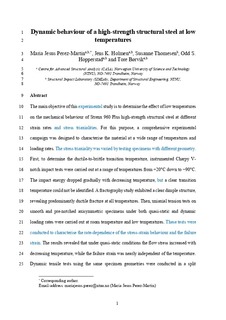| dc.contributor.author | Perez-Martin, Maria Jesus | |
| dc.contributor.author | Holmen, Jens Kristian | |
| dc.contributor.author | Thomesen, Susanne | |
| dc.contributor.author | Hopperstad, Odd Sture | |
| dc.contributor.author | Børvik, Tore | |
| dc.date.accessioned | 2019-10-04T08:31:53Z | |
| dc.date.available | 2019-10-04T08:31:53Z | |
| dc.date.created | 2019-10-02T14:26:39Z | |
| dc.date.issued | 2019 | |
| dc.identifier.citation | Journal of Dynamic Behavior of Materials. 2019, 5 (3), 241-250. | nb_NO |
| dc.identifier.issn | 2199-7446 | |
| dc.identifier.uri | http://hdl.handle.net/11250/2620235 | |
| dc.description.abstract | The main objective of this experimental study is to determine the effect of low temperatures on the mechanical behaviour of Strenx 960 Plus high-strength structural steel at different strain rates and stress triaxialities. For this purpose, a comprehensive experimental campaign was designed to characterise the material at a wide range of temperatures and loading rates. The stress triaxiality was varied by testing specimens with different geometry. First, to determine the ductile-to-brittle transition temperature, instrumented Charpy V-notch impact tests were carried out at a range of temperatures from + 20 °C down to − 90 °C. The impact energy dropped gradually with decreasing temperature, but a clear transition temperature could not be identified. A fractography study exhibited a clear dimple structure, revealing predominantly ductile fracture at all temperatures. Then, uniaxial tension tests on smooth and pre-notched axisymmetric specimens under both quasi-static and dynamic loading rates were carried out at room temperature and low temperatures. These tests were conducted to characterise the rate-dependence of the stress–strain behaviour and the failure strain. The results revealed that under quasi-static conditions the flow stress increased with decreasing temperature, while the failure strain was nearly independent of the temperature. Dynamic tensile tests using the same specimen geometries were conducted in a split Hopkinson tension bar at + 20 °C and − 40 °C. The material exhibited a positive strain rate sensitivity at all investigated temperatures. This experimental study reveals that the Strenx 960 Plus steel retains its ductility at temperatures as low as − 40 °C. Brittle failure could not be observed even with combined high strain rate, high stress triaxiality and low temperature. | nb_NO |
| dc.language.iso | eng | nb_NO |
| dc.publisher | Springer | nb_NO |
| dc.title | Dynamic Behaviour of a High-Strength Structural Steel at Low Temperatures | nb_NO |
| dc.type | Journal article | nb_NO |
| dc.type | Peer reviewed | nb_NO |
| dc.description.version | acceptedVersion | nb_NO |
| dc.source.pagenumber | 241-250 | nb_NO |
| dc.source.volume | 5 | nb_NO |
| dc.source.journal | Journal of Dynamic Behavior of Materials | nb_NO |
| dc.source.issue | 3 | nb_NO |
| dc.identifier.doi | https://doi.org/10.1007/s40870-019-00206-x | |
| dc.identifier.cristin | 1733077 | |
| dc.description.localcode | This is a post-peer-review, pre-copyedit version of an article published in Journal of Dynamic Behavior of Materials. Locked until 24 June 2020 due to copyright restrictions. The final authenticated version is available online at: https://doi.org/10.1007/s40870-019-00206-x. | nb_NO |
| cristin.unitcode | 194,64,45,0 | |
| cristin.unitname | Institutt for konstruksjonsteknikk | |
| cristin.ispublished | true | |
| cristin.fulltext | postprint | |
| cristin.qualitycode | 1 | |
